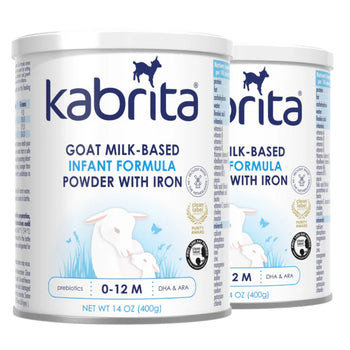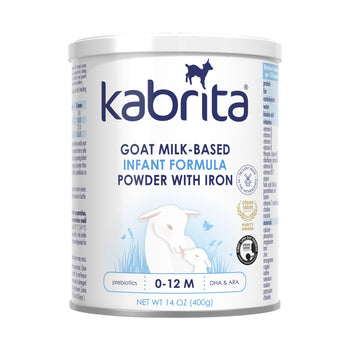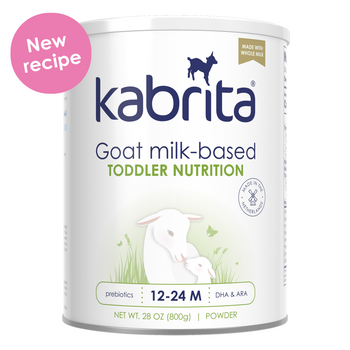Goat Milk Nutrition for Pediatric Health Professionals

Information for Health Professionals
Online searches for the term ‘goat milk formula’ have almost doubled in the last five years. Are you prepared to counsel your patients on the benefits, indications, and contraindications of goat milk-based nutrition?
Read on to learn about goat milk-based nutrition, and how it might impact your patients’ health.
Goat milk is rich in many nutrients but must be fortified for little ones
Goat milk is a good source of many nutrients including protein, calcium, phosphorous, magnesium, and vitamin A1. However, it lacks others, notably folate and iron, which are especially important for children. Goat milk formula, just like cow milk formula, is adapted and fortified with key nutrients in order to be suitable.
For patients looking to use goat milk formula with little ones, provide education on the importance of a safely fortified goat milk formula to prevent nutritional deficiencies.
Goat milk protein is easier to digest than cow milk protein
Goat milk protein forms a softer, smaller, and looser curd in the gut compared to cow milk protein2, which may make it easier to digest. This is due, in part, to the relative amount of alpha S1 casein in each. Alpha S1 casein contributes to the size and tension of the coagulate in the stomach. Goat milk contains significantly less alphaS1 casein than cow milk2, contributing to its ease of digestion. Goat milk whey has also been shown to digest faster than cow milk whey3.
Goat milk-based nutrition, such as a suitably fortified goat milk or goat milk formula, may be an option for patients seeking a nutritious cow milk alternative or with minor issues associated with cow milk consumption.
Goat milk naturally contains lactose, which most young children digest well
Goat milk, cow milk, and breast milk all contain lactose, which is molecularly identical regardless of the source. Lactose has also been shown to support the gut microbiome4 and aid in calcium absorption5 of little ones.
While some parents may believe their child has lactose intolerance, true lactose intolerance is uncommon under the age of three6.
For patients who suspect lactose intolerance in their young child, consider other potential causes for symptoms, such as difficulty digesting the protein in cow milk.
Goat milk contains prebiotics that may support intestinal flora
Research has shown that goat milk naturally contains 6x more gut-supportive prebiotic oligosaccharides than cow milk 7. Additionally, goat milk formula has been shown to contain 14 different types of oligosaccharides, 5 of which have similar structures to human milk oligosaccharides8.
For patients with minor gut issues or those wishing to support gut flora, goat milk-based nutrition may be a good option.
Goat milk-based products are not suitable for children with cow milk protein allergy
While goat milk protein may be easier to digest than cow milk protein, children with a confirmed cow milk protein allergy may also react to goat milk proteins. Goat milk-based foods, including formula, are not suitable for children with CMPA.
Patients with confirmed cow milk protein allergy should be counseled not to consume goat milk products. However, goat milk foods may be an option for those with minor issues associated with cow milk.
Goat milk-based foods are becoming more available in the US
Goat milk yogurt, cheeses, and snacks are increasingly available at major in-store and online retailers throughout the US. While goat milk infant formula is available in many countries, there is currently no approved option in the US. Illegally imported European formulas may pose risks to babies and are not recommended by pediatric leaders, including the American Academy of Pediatrics 9. Currently, Kabrita USA offers a Goat Milk Toddler Formula and is working towards bringing the first goat milk infant formula to the US market, per FDA’s guidelines.
1. Park YW., et al., Physico-chemical characteristics of goat and sheep milk. Small Ruminant Research, 2007; 68(1): p. 88-113.
2. Park YW. Hypo-allergenic and therapeutic significance of goat milk. 1994 Small Rumin. Res.14,151–16
3. Pintado ME, et al. Hydrolysis of ovine, caprine and bovine whey proteins by trypsin and pepsin. Bioprocess Engineering 2000;23:275-282.
4. Francavilla R, et al. Effect of lactose on gut microbiota and metabolome of infants with cow’s milk allergy. Pediatr Allergy Immunol. 2012 Aug; 23(5):420-7.
5. Hae-Soo K, et al. Revisiting lactose as an enhancer of calcium absorption. International Dairy Journal, Volume 22, Issue 2, 2012, Pages 147-151.
6. Heyman MB (Committee on Nutrition). Lactose intolerance in infants, children, and adolescents. Pediatrics, 2006. Sep; 118(3):1279-86.
7. Urashima, T., & Taufik, E. (2011). Oligosaccharides in Milk: Their Benefits and Future Utilization. Media Peternakan,33(3),189.
8. Leong, A, et al. Oligosaccharides in goat milk-based infant formula and their prebiotics and anti-infection properties. Br J Nutr. 2019 June:1-26
9. Fuchs G. Imported infant formula not reviewed by FDA may post health risks. May 11, 2018, AAP.



